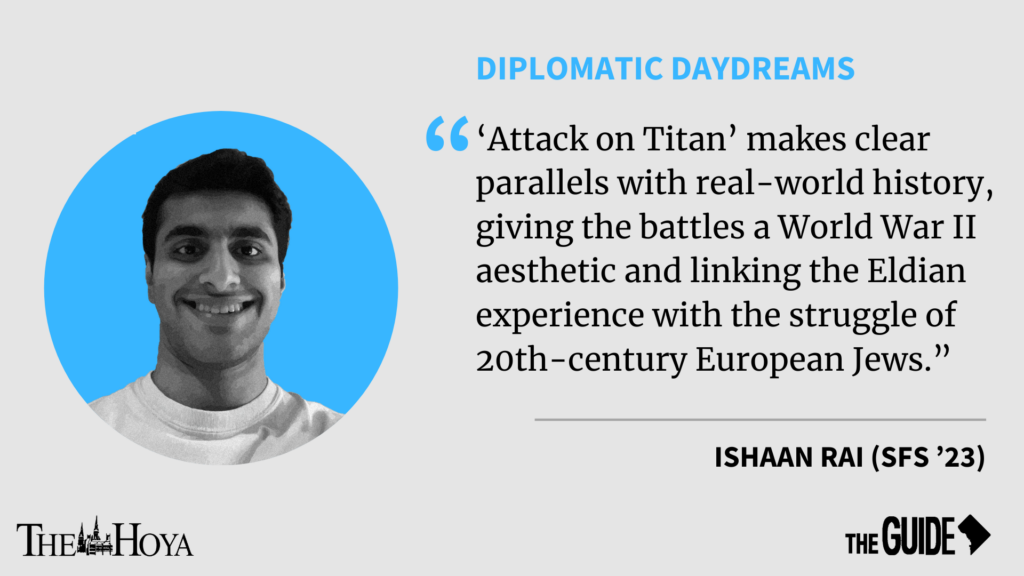*This review contains spoilers.
After a spectacular 12-year run, Japanese artist Hajime Isayama recently released the 139th and final chapter of his smash hit comic series, or manga, “Attack on Titan.” Since its beginning in 2009, the manga has become a worldwide success, selling over 100 million copies and becoming the 15th bestselling manga of all time.
“Attack on Titan” is a dark fantasy series in the shonen genre, or the genre of manga that is marketed toward teenage boys, which tells the story of an apparently post-apocalyptic, low-technology future in which humanity has been forced to retreat behind a ring of massive walls to protect from the titular Titans, terrorizing giants who do not sleep and who devour humans for pleasure.
After his mother is eaten, the headstrong teenager Eren Yeager, the protagonist of the story, joins the Survey Corps, a branch of the military dedicated to killing Titans. Over the course of the story, Eren discovers he has the ability to transform into a giant — a power he uses to defeat the Titans and unravel the secrets of the world beyond the walls.
The plot is dark and gory, but I was drawn to the manga for its thrilling action, such as scenes of soldiers encircling Titans with grappling hooks and slicing their heads off with swords. The boldness of the manga’s characters is also a strong point, with the soldiers of the Survey Corps displaying tenacious resolve in the face of insurmountable odds and keeping focused on their goal of freeing humanity.
Some people have criticized Isayama’s illustration as less skilled than that of some of his manga contemporaries, but he makes up for it with his imagination, his visceral, kinetic shots of human-giant duels and his creative manipulation of panels.
As the plot progresses, it challenges the initial assumptions of the story. The humans within the walls are revealed to be part of a race known as Eldians, who once ruled the world through inherited powers of Titan shapeshifting. The Eldians were overthrown, forcing much of the race to flee to an isolated island.
In the second half of the series, Eren and his comrades encounter the outside world, which resembles Earth in the mid-20th century and is rife with hatred for Eldians because of their Titan blood. Just as the nation of Marley is planning an invasion of Eldia in an attempt to steal Eren’s shapeshifting power, the Eldian army launches a preemptive strike, leading to war between the two nations.
“Attack on Titan” makes clear parallels with real-world history, giving the battles a World War II aesthetic and linking the Eldian experience with the struggle of 20th-century European Jews. A majority of the characters have German-inspired names, and the Eldians who had been left behind in Marley are portrayed as living in segregated ghettos and being forced to wear starred armbands.
The Eldians are also accused of being cursed because of their Titan bloodline and the crimes of their ancestors, similar to the antisemitic Medieval European conspiracy theory of Jewish deicide, which stated Jews were collectively responsible for the death of Jesus and were thus cursed for eternity.
The specter of fascism looms strongly over the series. The nations of Eldia and Marley are ruled by military dictatorships mobilizing child soldiers in never-ending warfare, and hatred between the races is seemingly insurmountable. However, the manga does not endorse fascism, as some have erroneously claimed. Neither is it a one-to-one allegory of Jewish history. Rather, Isayama draws from that history to illuminate themes like the corrosive cycle of hatred and how dehumanization of the enemy leads to senseless destruction.
Despite the story’s compelling themes, many fans were left disappointed with the manga’s conclusion, partially because of the perception it was rushed. Isayama was not able to tie his pieces together into the profound message he seemed to be promising, and certain plot threads were left bizarrely unexplained.
Even with the ending’s problems, there is no doubt of this manga’s quality and influence. Both the manga and its anime adaptation have become prominent elements of Japanese pop culture in the West. In 2019, manga was the second bestselling category of comic books in the United States, far outselling the superhero comics of Marvel and DC, and “Attack on Titan” is part of this surge. “Attack on Titan” remains an exemplary piece of Japanese media, combining the thrilling action typical of shonen with sharp allegory and attempts to wrestle with the bigger questions raised by war and violence.














